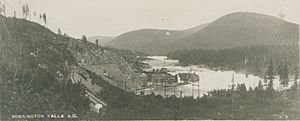Bonnington Falls facts for kids
Bonnington Falls were a series of powerful waterfalls on the Kootenay River in southern British Columbia, Canada. Today, these waterfalls are no longer visible because they were covered by large dams. The dams were built to create electricity using the river's strong flow.
The falls were located between the cities of Castlegar and Nelson, in a beautiful area called the West Kootenay region.
Contents
What Were Bonnington Falls?
Bonnington Falls were a natural wonder, made up of several drops in the Kootenay River. The upper part of the falls was even named after another famous waterfall, the Bonnington Linn, which is part of the Falls of Clyde in Scotland. This shows how impressive the Bonnington Falls must have been!
Building Dams for Power
For many years, people have used the power of flowing water to create electricity. This is called hydroelectric power. The Bonnington Falls were a perfect spot for this.
Early Power Plants
- In 1896, a company called West Kootenay Power and Light built the first dam and power station at the lower part of the falls. This was a big step for the region.
- They built a special power line to carry electricity to the mines in Rossland. This line was about 51 kilometers (32 miles) long. At the time, it was the longest high-voltage power line in the world! This meant it could carry a lot of electricity over a long distance.
- Later, in 1908, the City of Nelson built its own hydroelectric dam at the upper part of the falls. This helped provide more electricity for the growing city.
Modern Dam Construction
- Much later, in 1976, a company called BC Hydro built another dam. This one was on a special channel called the Kootenay Canal, which diverts some of the river's water. This new dam helped create even more clean energy.
The Community of Bonnington Falls
Right next to where the falls used to be, there is a small community. It is also called Bonnington Falls, British Columbia. This community grew because of the power plants and the people who worked there.



